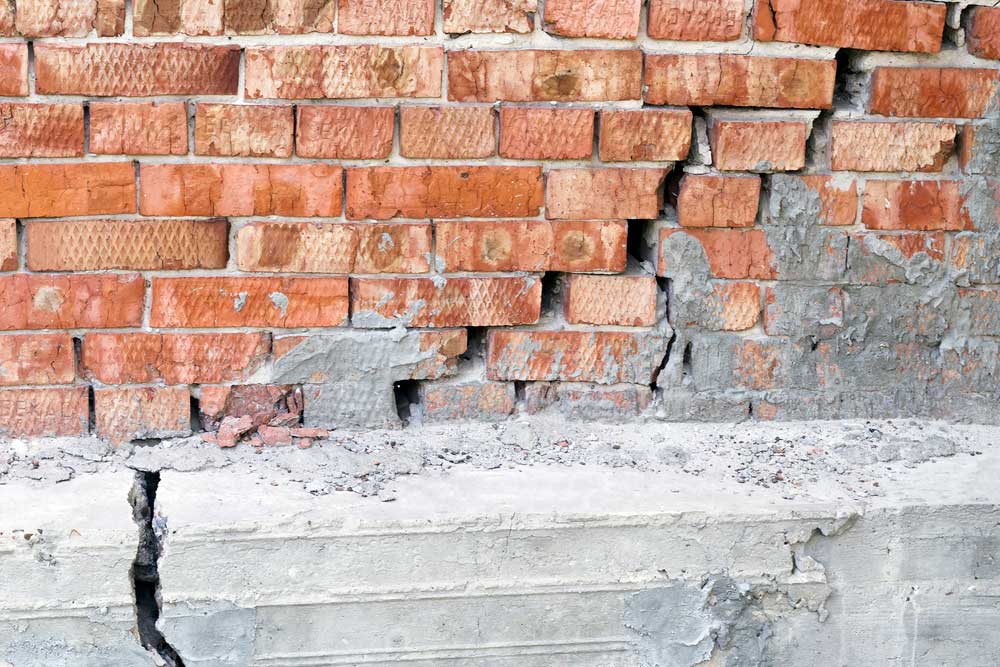If your home has a settling foundation, it’s important to fix the problem as soon as possible. But the foundation repair technique that your home needs will depend on a number of factors, which can include the following:
- The symptoms that your home is experiencing.
- The composition and compaction of the soil underneath.
- How far down stable conditions are located.
- The type of foundation that’s in need of support.
Most foundation repair methods aren’t considered to be DIY projects, so they will require the skills of a trained professional. You do, however, need to understand the situation and know which options are available because they can be valuable tools in finding the right person for your specific set of circumstances.

Identifying Foundation Problems
Foundation problems can show themselves in subtle ways during the early stages. You may see small cracks in the walls, or there may be some water intrusion after a period of heavy rain. They’re often minor issues, so they may not be signs of a bigger problem. They can, however, be early symptoms of a major issue that may come up later on if they’re not taken care of. If you see any of these potential warning signs, you should have a professional take a look at it so he or she can assess the situation.
Other signs of a foundation problem can include the following:
- Doors that don’t open or close as easily.
- Windows that become harder to operate.
- Gaps developing in the trim work.
- Cracks in the drywall.
All of these issues are signs that your foundation is in need of repair.
Permanent Foundation Repair
There are several ways to restore the support for your home’s foundation, but the best options will depend on the soil composition underneath the house and what type of foundation is in need of repair. The primary methods for permanent foundation repair include:
- Steel Piers — In most cases, installing steel piers underneath your home will be the best long-term solution for stabilizing a foundation. But it’s also the most expensive. This type of foundation repair involves the use of galvanized steel posts, which are driven deep into the ground below the foundation.
- Hellical Piers — This foundation repair method also involves the use of galvanized steel, except they are twisted into the ground with a hellically-shaped leading point that looks like a screw or auger. This is a great way to support the massive weight of a home and foundation without having to reach the bedrock.
- Concrete Piles — These are blocks or cylinders of pre-cured concrete, which have a length and width of several inches to many feet. The piles are driven or placed underneath the foundation into the compacted soil and can either consist of one piece or several pieces that are stacked on top of each other.
- Poured Concrete Piers — This is a low-cost foundation repair technique that can work if the conditions under your home are right. A large hole is dug under your foundation, which is filled with wet concrete. Then, it’s allowed to cure before it’s attached to your home.
Be sure to speak to a foundation repair expert for more information.
Minor Foundation Adjustments
There are times when your home has a foundation problem that isn’t severe enough to justify a more involved repair, but it still needs to be dealt with before it gets worse. The main methods for making minor foundation adjustments include:
- Slab Jacking — If your home sits on a concrete slab that isn’t level or has cracks caused by soil erosion, this foundation repair method may solve the problem. It involves drilling holes into an existing slab and injecting a concrete slurry or dense polyurethane foam under the failing section. If your home sits on soil that is compact enough, this method can be a good solution for fixing a sagging foundation.
- Shimming — New homes are sometimes built on soil that may not have been compacted enough before the foundation was built. And after the home has been completed, that soil can shift or erode. This can cause gaps to form between the foundation and the rest of the home’s structure. These conditions may or may not be the sign of a larger problem, but a foundation expert or structural engineer may decide to fill the gap with steel shims after he or she has looked at the situation. This can act as a permanent solution if the soil has stopped settling under the home. But if the gaps reappear, a more invasive foundation repair will most likely be needed.
If you’re looking for one of the best places for foundation repair in Corpus Christi, be sure to reach out to Streem Foundation Repair.

